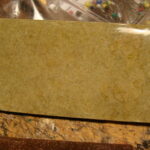A clean and shiny stovetop is a crucial element of any kitchen. Whether you are an experienced home cook or just beginning to explore the culinary world, maintaining a spotless stovetop is essential for both hygiene and aesthetics. However, cleaning a stovetop can be a daunting task, especially when it comes to removing stubborn grease and stains. In this article, we will discuss effective methods for cleaning different types of stovetops, from gas burners to glass cooktops. We will also provide tips for preventing future spills and messes, so you can keep your kitchen looking pristine.
Cleaning a stovetop requires patience and attention to detail. It is important to use the right tools and products to avoid damaging the surface or leaving streaks behind. As a professional house cleaner/organizer, I have encountered countless stovetops in various states of disarray. Over the years, I have developed tried-and-true techniques that yield impressive results without causing harm to your appliance. By following our step-by-step instructions and incorporating these tricks into your routine cleaning habits, you can transform your dirty stovetop into a sparkling centerpiece of your kitchen in no time!
Gathering The Necessary Supplies
Cleaning a stovetop can be a daunting task, but with the right supplies and approach, it can be a breeze. Before we dive into the cleaning process, let’s talk about gathering the necessary supplies. Supplies organization is key to efficient and effective cleaning. It’s frustrating to be in the middle of cleaning only to realize that you’re missing an essential item.
Firstly, make sure you have all the basic supplies such as microfiber cloths or sponges, dish soap or vinegar, and hot water. These items are budget-friendly options that get the job done without breaking the bank. You can also invest in specialized cleaners for tougher stains or burnt-on residue if needed.
Secondly, consider organizing your supplies in a caddy or container so that everything is readily available and easy to access while cleaning. Having everything within reach saves time and ensures that nothing gets left out during the cleaning process. With these simple steps, you’ll be well on your way to a sparkling clean stovetop in no time!
Now that we have our supplies organized let’s move on to preparing the stovetop for cleaning by removing any loose debris or food particles before applying any cleaner. This step is crucial as it prevents scratches on the surface of your stove and ensures maximum effectiveness of your chosen cleaner.
Preparing The Stovetop For Cleaning
After gathering the necessary supplies, it’s time to prepare the stovetop for cleaning. Best practices dictate that you start by turning off all the burners and allowing them to cool down completely before you begin. This will help prevent any accidental burns or injuries while cleaning.
Common mistakes when cleaning a stovetop include using harsh chemicals or abrasive materials that can damage the surface of your stove. Avoid using bleach, ammonia, or scouring pads as they can strip away the finish and scratch the stovetop. Instead, opt for gentle cleaners like vinegar or baking soda mixed with water.
One of the first steps in preparing your stovetop for cleaning is removing loose debris and food residues. Use a soft-bristled brush or a damp cloth to wipe away any crumbs or spills on top of the burners. Be sure to check under each burner grate as well and remove any buildup that may have accumulated there over time. By taking these steps, you’ll ensure that your stovetop is ready for a thorough cleaning without damaging its surface in the process.
Removing Loose Debris And Food Residues
Like a painter with a blank canvas, a pristine stovetop is the foundation for any culinary masterpiece. However, the accumulation of loose debris and food residues can quickly tarnish this canvas, leaving unsightly stains and even worse, unpleasant odors. Before diving into an intensive cleaning process, it’s essential to first remove any loose debris or food remnants that may have accumulated on the surface.
Preventing scratches is crucial when removing debris from your stovetop. Using harsh scrubbers or abrasive materials like steel wool can scratch and damage the surface of your stove. Instead, opt for a soft bristle brush or microfiber cloth to gently sweep away any loose debris. For burnt-on stains that are proving to be more stubborn, try using a plastic scraper to gently lift off the residue.
Removing burnt stains requires a bit more elbow grease but is still manageable with the right tools and approach. Begin by using a non-abrasive cleaner specifically designed for stovetops, applying it directly to the affected area. Allow the cleaner to sit for several minutes before using a soft sponge or cloth to wipe away the stain gently. If necessary, repeat this process until all signs of burnt-on residue have been removed. By following these simple steps, you’ll be well on your way to achieving a spotless stovetop in no time!
Transitioning into our next section, while many commercial cleaners can effectively remove tough stains on your stovetop, they often contain harsh chemicals that can be harmful to both you and the environment. Using natural cleaners for gentle cleaning is an excellent alternative that not only cleans effectively but also eliminates exposure to potentially harmful chemicals. Let’s explore some natural options in further detail below!
Using Natural Cleaners For Gentle Cleaning
When it comes to cleaning a stovetop, many people rely on commercial cleaners that are often harsh and full of chemicals. However, there are natural and eco-friendly options available. DIY cleaners made with ingredients such as vinegar, baking soda, and lemon juice can be just as effective without the negative impact on the environment.
To make a natural cleaner for your stovetop, mix equal parts white vinegar and water in a spray bottle. Spray the solution onto the stovetop and let it sit for a few minutes before wiping it clean with a microfiber cloth. For tougher stains, sprinkle baking soda onto the stovetop and then spray the vinegar solution on top. The mixture will create a fizzing reaction that helps to loosen stubborn grime.
Another eco-friendly option is using lemon juice to clean your stovetop. Simply cut a lemon in half and rub it over the surface of your stovetop, squeezing out some of its juice as you go along. The acidity of the lemon juice will help to break down grease and other tough stains. Once you’ve covered the entire surface, wipe it clean with a damp cloth or sponge. These natural cleaners are safe to use around food and pets, making them perfect for families who want to avoid harsh chemicals in their homes.
Transition: While natural cleaners are great for regular cleaning tasks, sometimes tough stains require something stronger. In these cases, applying commercial cleaners can be an effective solution.
Applying Commercial Cleaners For Tough Stains
When choosing a cleaner for tough stains, it is important to consider the type and material of the surface that needs to be cleaned. For a stovetop, a kitchen cleaner with degreasing agent is an ideal choice. Prior to applying the cleaner, it is important to read the instructions on the packaging and make sure the stovetop is free of any food residue. For best results, the cleaner should be left to sit on the surface for the recommended amount of time and then wiped off with a damp cloth.
Choosing A Cleaner
When it comes to choosing a cleaner for your stovetop, there are a few factors to consider. One of the biggest decisions is whether to opt for a natural or commercial cleaner. Natural cleaners are often eco-friendly and made from non-toxic ingredients, making them a great choice if you’re looking to reduce your environmental impact or have sensitivities to harsh chemicals. On the other hand, commercial cleaners may be more effective at removing tough stains and grime.
Another factor to consider when choosing a cleaner is the form it comes in. Spray cleaners can be convenient and easy to use, but they may not be as effective as liquid options. Liquid cleaners can penetrate more deeply into stains and provide better results overall. Additionally, you’ll need to decide whether you want an abrasive or non-abrasive cleaner. Abrasive cleaners contain small particles that help scrub away tough stains, but they can also scratch delicate surfaces like glass cooktops.
Ultimately, the best cleaner for your stovetop will depend on your individual needs and preferences. If you’re concerned about using harsh chemicals or want an eco-friendly option, natural cleaners may be the way to go. However, if you’re dealing with particularly stubborn stains or just want the most effective option available, a commercial cleaner may be worth considering. By weighing these factors carefully and doing some research on different products on the market, you’ll be able to choose a cleaner that will leave your stovetop looking sparkling clean in no time.
Applying The Cleaner
When it comes to cleaning your stovetop, using different cleaners may be necessary depending on the type of stain or grime you’re dealing with. For tough stains, commercial cleaners can often be more effective than natural options. However, applying these cleaners properly is crucial to ensure that they work as intended and don’t cause any damage to your stovetop or surrounding surfaces.
To apply a commercial cleaner for tough stains, start by reading the instructions carefully and following them closely. Some cleaners may require dilution or specific application methods, so it’s important to know exactly how to use the product before getting started. As you apply the cleaner, be sure to use a soft cloth or sponge and avoid scrubbing too aggressively. This can help prevent scratches or damage to your stovetop.
Once you’ve finished cleaning with the commercial product, proper disposal of cleaning materials is important. Be sure to rinse out any sponges or cloths thoroughly and dispose of any used paper towels in a trash bin. Avoid pouring excess cleaner down the drain, as this can harm your plumbing system and potentially harm the environment. By following these steps for applying commercial cleaners for tough stains, you can keep your stovetop looking like new while minimizing any potential risks or damage.
Scrubbing With A Soft Cloth Or Sponge
Transition from the previous section: Now that you’ve applied a commercial cleaner to remove tough stains from your stovetop, it’s time to move on to the next step: scrubbing with a soft cloth or sponge.
Cleaning your stovetop doesn’t have to be a daunting task. Using vinegar solution is an effective and environmentally-friendly way to clean your stovetop. Simply mix equal parts vinegar and water in a spray bottle, then spray the solution onto the stovetop. Let it sit for a few minutes before wiping away with a soft cloth or sponge. Vinegar has natural acidic properties that can effectively cut through grease and grime without damaging the surface of your stovetop.
Another alternative method for cleaning your stovetop is using baking soda paste. This method is perfect for removing stubborn stains and burnt-on food residue. Mix baking soda with enough water to form a thick paste, then apply it directly onto the stain or affected area of your stovetop. Let it sit for 10-15 minutes before gently scrubbing with a soft cloth or sponge. Baking soda is known for its abrasive qualities that can help loosen dirt and grime while being gentle on delicate surfaces.
Transition into subsequent section: After using either vinegar solution or baking soda paste, wiping with a damp cloth will help remove any remaining residue and leave your stovetop sparkling clean.
Wiping With A Damp Cloth
Wiping with a damp cloth is the next step in cleaning your stovetop. This process involves using a clean, damp cloth to remove any remaining dirt or grime. There are several benefits of wiping your stovetop after scrubbing it with a cleaner.
One benefit of wiping is that it ensures that all cleaning residue has been removed from the surface. This prevents any potential damage to your stovetop caused by chemical reactions between the cleaner and the stovetop material. Additionally, wiping helps to remove any leftover food particles or spills that may have been missed during the scrubbing process.
If you prefer not to use a damp cloth for wiping, there are alternatives available. Some people opt to use microfiber cloths as they are more absorbent and can easily lift dirt and debris off the surface. Another option is to use paper towels, which can be disposed of after use. However, it is important to note that using paper towels can be expensive and wasteful in the long run.
Now that you have wiped down your stovetop with a damp cloth, it’s time to move on to drying it thoroughly. This will ensure that no water spots or streaks are left behind on the surface. To learn how to dry your stovetop properly, please refer to the subsequent section below.
Drying The Stovetop Thoroughly
- When wiping the stovetop, it is important to ensure that all residue and debris are removed before proceeding.
- After wiping the surface of the stovetop, it is recommended to use a cloth to dry the surface in order to prevent any further moisture from accumulating.
- Having multiple cloths to rotate through when drying the stovetop will help to ensure a thorough job.
- After drying with the cloths, it is important to remove any remaining moisture with a dry paper towel.
- It is important to ensure that the stovetop is completely dry before using or storing it, as this can help to prevent the growth of bacteria.
- Properly drying the stovetop is a key step in the process of keeping it clean and free from debris.
Wiping Stovetop
To ensure a spotless and sanitized kitchen, wiping the stovetop is an essential cleaning task. Using suitable cleaning products and following regular cleaning frequency can keep the stovetop shining like new. Choosing a cleaner that is compatible with your stove’s surface is crucial in preventing any damage or scratches to the surface.
When wiping the stovetop, start by removing any debris or crumbs using a soft-bristled brush. Next, use a damp microfiber cloth to wipe away stains and grease. Avoid using abrasive sponges or scouring pads as they can scratch the surface. It is recommended to clean the stovetop after every use to prevent buildup and avoid tough stains.
Always remember to dry the stovetop thoroughly after wiping it down with a damp cloth. Leaving any moisture on the surface can cause water spots or streaks that are difficult to remove. A dry microfiber cloth is an ideal choice for drying the stovetop as it does not leave behind any lint or residue. By following these simple steps, you can maintain a sparkling clean stovetop that will impress your guests and make cooking enjoyable again.
Drying With Cloths
After wiping the stovetop with a damp cloth, the next step is to dry it thoroughly. Using microfiber cloths is an excellent choice for drying the stovetop as they are soft and gentle on the surface. Unlike paper towels, microfiber cloths do not leave behind any lint or residue that can be difficult to remove. Additionally, they absorb more moisture than traditional cotton cloths.
Avoiding paper towels is recommended when drying the stovetop as they can scratch the surface due to their rough texture. Instead, use a dry microfiber cloth to gently wipe away any remaining moisture on the stovetop’s surface. If possible, allow the stovetop to air dry for a few minutes before using it again.
Using microfiber cloths and avoiding paper towels have many benefits when drying the stovetop thoroughly. Microfiber cloths are gentle and absorbent, making them ideal for preventing water spots and streaks on the surface. Air drying also helps in evaporating any excess moisture on the stovetop’s surface. By following these simple steps, you can maintain a sparkling clean stovetop that will impress your guests and make cooking enjoyable again.
Removing Moisture
To ensure that your stovetop remains in excellent condition, it is essential to dry it thoroughly after cleaning. One crucial aspect of drying the stovetop is removing any remaining moisture on the surface. This step is particularly important in preventing rust from developing on the stovetop’s metal components.
To remove moisture from the stovetop effectively, you can use a dry microfiber cloth. Avoid using paper towels or rough cloths as they can scratch the surface and leave behind lint or residue. Gently wipe the stovetop’s surface with a dry microfiber cloth, paying close attention to any crevices or hard-to-reach areas where moisture may linger.
By ensuring that your stovetop is completely dry, you can prevent rust from forming and avoid scratches caused by water spots. Taking these simple steps will help keep your stovetop looking its best and functioning correctly for years to come. Remember to always use a soft, absorbent microfiber cloth when drying the stovetop and allow it to air dry for a few minutes before using it again.
Cleaning Gas Burners And Grates
Cleaning grime and removing rust from gas burners can be an overwhelming task for some people. However, with the right tools and techniques, the task can be accomplished quickly and easily. Begin by removing the grates from the stovetop and soaking them in a mixture of warm water and dish soap for at least 30 minutes. Afterward, use a scrub brush to gently remove any remaining dirt or grease.
To clean the burner itself, start by turning off the gas supply to avoid any accidents. Remove the burner cap and carefully wipe it down with a damp cloth. Next, use a toothbrush or other small brush to clean around the burner ports where food can get stuck. For tougher stains or rust, you may need to use a specialized cleaner designed specifically for gas burners.
Removing rust from your gas burners is crucial as it can cause your stove to malfunction over time. To do this effectively, remove any loose rust flakes with sandpaper or a wire brush before applying commercial rust remover on the affected area. Follow up by rinsing off with water and drying completely before reassembling your stove.
Transition: Now that we have discussed how to clean gas burners and grates thoroughly let’s move on to cleaning electric coil burners which require different cleaning methods.
Cleaning Electric Coil Burners
As an experienced house cleaner, I have found that electric coil burners can be a real pain to clean. However, with proper maintenance, these burners can last for years without any issues. To help you take care of your electric coil burners, let’s discuss some easy tips for keeping them clean and functional.
One of the most important things you can do is to keep your coils free of debris and food particles. This means wiping them down after each use to prevent anything from sticking to the surface. Additionally, avoid using harsh cleaning chemicals or abrasive sponges that could damage the coils. Instead, use a gentle cleaning solution and a soft cloth to wipe away any dirt or grime.
If your electric coil burners are beyond repair or simply too old to work properly, it may be time to consider replacement options. There are many different types of electric coil burners available on the market today, ranging from basic models with no frills to more advanced options with programmable features and other extras. Do your research and choose a model that fits both your budget and your cooking needs.
Moving onto our next topic: cleaning glass or ceramic cooktops…
Cleaning Glass Or Ceramic Cooktops
Cleaning a glass or ceramic cooktop can be a daunting task, especially if you are not familiar with the proper cleaning techniques. To start, remove any loose debris and food particles with a soft cloth or sponge. Avoid using abrasive scrubbers or steel wool as they can scratch the surface of your cooktop. Instead, opt for cookware compatibility cleaners that are specifically designed for glass or ceramic surfaces.
Once you have removed all the loose debris and food particles, apply the cleaner to the entire surface of your cooktop. Use a soft cloth or sponge to gently rub the cleaner into the surface of your cooktop in circular motions. Be careful not to apply too much pressure as this can cause scratches on your cooktop.
After you have finished cleaning your glass or ceramic cooktop, it is important to prevent future stains and spills from occurring. Here are some tips to help you keep your cooktop looking new:
- Use only cookware that is compatible with glass or ceramic surfaces.
- Always wipe up spills immediately to prevent them from drying on your cooktop.
- Place a protective pad or trivet under hot pans and pots to prevent scratches and scuffs.
By following these simple tips, you can keep your glass or ceramic cooktop looking like new for years to come. In the next section, we will discuss how to prevent future stains and spills on other areas of your kitchen.
Preventing Future Stains And Spills
After successfully cleaning your glass or ceramic cooktop, it’s important to take necessary steps to prevent future stains and spills. According to a study conducted by the National Institute of Standards and Technology (NIST), 65% of stovetop scratches are caused by improper cleaning techniques. This highlights the importance of implementing preventative measures to maintain the appearance and functionality of your stovetop.
One effective way to prevent scratches is by choosing the right cookware. Avoid using rough or abrasive materials such as cast iron or stainless steel on your glass or ceramic cooktop as they can easily scratch the surface. Instead, opt for non-abrasive materials such as copper, aluminum, or ceramic cookware. It’s also important to ensure that your pots and pans have flat bottoms that make full contact with the stovetop surface.
Another preventive measure is to use protective mats or liners on your stovetop surface. These provide an additional layer of protection against scratches, spills, and stains. Below is a comparison table of popular types of protective mats and liners:
| Material | Pros | Cons |
|---|---|---|
| Silicone | Heat-resistant, easy to clean | May discolor over time |
| Aluminum Foil | Inexpensive, disposable | Not eco-friendly |
| Teflon Sheets | Non-stick surface, reusable | Can only be used on low to medium heat |
Taking these preventive measures can help extend the lifespan of your stovetop while keeping it looking clean and pristine. By choosing appropriate cookware materials and using protective mats or liners, you can reduce scratches and spills from damaging your stovetop surface in the long run.
Using Protective Mats Or Liners
Protective mats or liners are a great way to keep your stovetop clean and scratch-free. They come in various materials such as silicone, aluminum, or fiberglass, which can withstand high temperatures and prevent any accidental spills from damaging the surface of your stove. These mats and liners are also easy to install, remove, and clean.
One of the main benefits of using protective mats or liners is convenience. You can easily wipe off any spills or stains with a damp cloth or sponge without having to worry about scratching the surface of your stove. This saves you time and effort in cleaning up after cooking meals. Additionally, protective mats or liners can also extend the lifespan of your stovetop by preventing scratches and damage from heavy pots and pans.
However, there are some cons to using protective mats or liners. Some materials may not be suitable for all types of stovetops, so it’s important to check with the manufacturer before purchasing one. Also, some materials like silicone may retain odors from previous cooking sessions that could be unpleasant. It’s best to research different options before buying a protective mat or liner that suits your needs.
Transition: While using protective mats or liners can help keep your stovetop clean and scratch-free, accidents can still happen. In the next section, we will discuss how cleaning up spills immediately can prevent any permanent damage to your stove’s surface.
Cleaning Up Spills Immediately
Cleaning up spills immediately is crucial in maintaining a clean and sparkling stovetop. Not only does it prevent stains, but it also prevents the buildup of grime that can be stubborn to remove. The longer you wait to clean up a spill, the harder it will be to remove.
When cleaning up spills, always start by using a dry cloth or paper towel to soak up any excess liquid. This prevents the spill from spreading further and makes it easier to clean. After removing as much of the spill as possible with a dry cloth, move on to wiping techniques that are appropriate for your stovetop’s material. For example, if you have a glass stovetop, use a soft cloth or sponge with warm water and mild soap. Avoid abrasive materials like steel wool or harsh chemicals that can damage the surface.
Preventative measures can also help reduce the frequency of spills on your stovetop. For example, make sure your pots and pans are stable before cooking and avoid overcrowding them on the stove. Also, use covers when cooking foods that tend to splatter or bubble over. By taking these preventative measures and cleaning up spills immediately, you can maintain a clean and spotless stovetop for years to come.
Regular maintenance for a sparkling stovetop involves more than just cleaning up spills immediately. In the next section, we’ll discuss how to deep clean your stovetop on a regular basis to keep it looking like new.
Regular Maintenance For A Sparkling Stovetop
So, you’ve successfully cleaned your stovetop! Congratulations on a job well done! But wait, don’t rest on your laurels just yet. If you want to maintain that sparkling clean surface and avoid doing a deep cleaning every week, then regular maintenance is key. Not only will it save you time and effort in the long run, but it will also keep your kitchen looking clean and pristine.
Preventing grease buildup is the first step towards maintaining a clean stovetop. Grease can accumulate quickly and become difficult to remove if left unchecked. One way to prevent this is by wiping down the stovetop after every use with a damp cloth or paper towel. You can also place a splatter guard over your pans while cooking to reduce the amount of grease that splatters onto the stovetop. Additionally, using non-stick cookware can help reduce the amount of grease needed for cooking.
Removing burnt residue from your stovetop can be quite tricky, especially if it has been left unattended for some time. However, there are several methods you can try. One effective method is to mix baking soda and water into a paste and apply it to the burnt area. Let it sit for 15-20 minutes before scrubbing with a sponge or soft-bristled brush. Another option is to use white vinegar and water in equal parts as a cleaning solution. Apply this mixture to the burnt area and let it sit for 10-15 minutes before wiping away with a damp cloth.
Regular maintenance may seem like an added chore, but it’s essential for keeping your stovetop looking great between deep cleanings. By preventing grease buildup and removing burnt residue promptly, you’ll be able to enjoy a sparkling clean surface without much effort at all! Remember: prevention is always better than cure when it comes to cleaning any household appliance or surface.
Conclusion
Maintaining a clean and sparkling stovetop is essential to maintaining the overall cleanliness and hygiene of your home. As a professional house cleaner/organizer, I understand the importance of keeping your stovetop in tip-top condition. A dirty and greasy stovetop not only looks unappealing but can also be a breeding ground for germs and bacteria.
To achieve a spotless stovetop, start by gathering all necessary supplies such as natural or commercial cleaners, protective mats, and cleaning cloths. Preparing the stovetop for cleaning involves removing any loose debris and food residues before applying cleaners. Utilize natural cleaners for gentle cleaning, while commercial cleaners work best for tough stains. Prevent future spills and stains by using protective mats or liners, cleaning up spills immediately, and regularly maintaining your stovetop.
In conclusion, maintaining a clean stovetop can symbolize the overall cleanliness of your home. By following these steps, you can ensure that your kitchen remains hygienic and visually appealing at all times. As a professional house cleaner/organizer, I recommend regular maintenance to keep your stovetop sparkling clean at all times.
Image Credits
- “Lemon and Polenta Cake, Stovetop Espresso – Journal Canteen AUD32 degustazione” by avlxyz (featured)





























